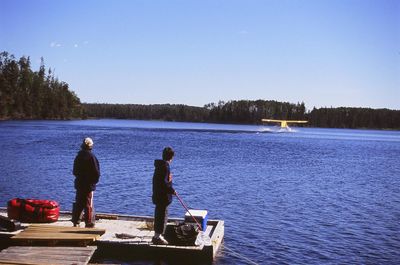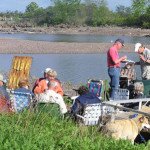As my fishing buddies will attest, I like gear. But my travels as a fishing writer have forced me to scale down my gear to the bare essentials. What I’ve learned is for 90 percent of my fly in trips, I can get by comfortably with 10 percent of my usual tackle. Here’s a look at how to prepare for a fly in.
Taking a fly in fishing trip into a remote lake requires some serious planning. You need to know the answers to the following questions before putting your gear together:
- Is there a weight restriction on the flight in?
- What will you be fishing for?
- What kind of weather can you expect?
- What kind of gear is provided with the boats at the outpost camps?
The weight restriction is probably the most critical factor. As a rule, fly in operators tend to restrict each person flying to an outpost camp or lodge to a maximum amount of weight. Generally, fly in camps restrict your luggage and gear to about 80 pounds per person. Weight restrictions are done for safety reasons, as overloading a plane is illegal and potentially dangerous.
I once saw a guy try to bring a car battery and trolling motor on his fly in. He was told he could, as long as he left all his fishing gear and clothing behind. The motor stayed on the dock. Weight restrictions mean scaling down all your terminal fishing tackle into one compact tackle bag. I really like the soft sided tackle boxes with the individual trays for fly in trips.
Take some time and pick tackle you know you’ll use. If you’re going into a walleye/pike/bass fishery, you can make individual trays of jigs and twister bodies, crank-baits, spoons, and whatever odds and ends you need (hooks, sinkers, steel leaders, snaps, etc.). You should also have pliers, forceps, jaw spreaders, a tape measure, a hook hone, and a small first aid kit in your tackle box.
Make sure you know what you’ll be fishing for and in what conditions. Secure your tackle so it won‘t spill out in the plane. I use a leather belt to tighten down the flaps on the soft tackle bag. Spilled tackle boxes can be very dangerous in a float plane.
As for rods, I usually bring as many as can fit in one large, hard shell rod tube. Generally, that’s two medium action spinning rods, a seven-foot flipping stick, and either an ultra-light spinning or a fly rod. Have a spare of whatever rod you are most likely to use. For some reason. I’ve broken more rods on fly in trips then on all my other trips combined.
Reels should be taken off the rod, and carefully packed with your clothes. Make sure you have at least one spare reel for each type of fishing you plan to do. Never show up to a float plane base with a handful of rigged rods. Loose rods and reels are an accident waiting to happen and most pilots hate storing them in the hold.
When it comes to clothing, be very selective about what you bring, but err on the side of warmth and dryness. You must have top quality rain gear. If it rains every day, you’ll be stuck in the cabin or frozen if you try to make do with a cheap plastic pancho. On summer fly ins, I’ll pack shorts as well as long pants (one pair fleece), a couple of T shirts, a long sleeve shirt, a turtle neck, long underwear, boxers, a wool sweater, a fleece pull-over, various warm socks, rubber boots, hiking boots, and rain gear. Also throw in a rain hat as well as a couple of baseball or sun hats.
Polaroid sunglasses, sunscreen, and bug dope are a must. In the spring and fall, I’ll bring winter clothes with me on all fly ins including a wool cap, gloves, snow pants, and a floater jacket. Some lodges and outposts supply approved personal floatation devices for everyone. If you have a life jacket that you are comfortable in , bring it. All my clothing is packed into a hockey bag sized waterproof bag. Mine is made by North Face and cost a couple skins, but it was worth it. If you’ve ever had a canvas bag sit on a float plane dock in the rain, you know how wet your gear can become. A waterproof bag solves that problem.
Most outpost camps don’t provide depth finders, although this has been changing in recent years. However, I always bring a portable sonar unit with two extra rechargeable 12 volt batteries as a spare. Even the most remote lakes can have secret stashes of fish most anglers miss. Having a depth unit helps you find reefs and other structure that hold them.





